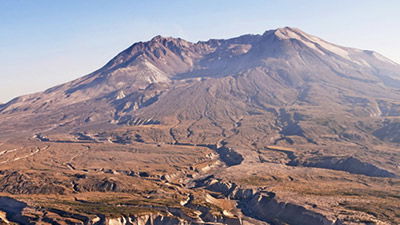Mount St. Helens
From Flood Geology
Foundation of Geological Timescale Shaken
The explosion of Mount St. Helens not only drastically changed the landscape of the Washington area in just a matter of months, it also dug deep holes in the idea that “millions of years” are needed for rock layer, canyon, and fossil formation. Mount St. Helens clearly testified that these things do not require long ages to form.
Just One Volcano
The eruption of Mount St. Helens was a rather small and localized event. If a small explosion like this could cause such catastrophic results, what could happen if there were larger explosions all over the globe?
A Study in Catastrophe
Mount St. Helens has served as an object of study for creationist researchers, who have learned about the effects of catastrophic geological processes and the speed at which the earth can change. From radiometric dating to a study of sedimentary layers and erosion, the Mount St. Helens eruption offered a real-world laboratory.
Articles About Mount St. Helens
-
July 1, 2020 from Answers Magazine
Forty years ago, one of the most violent natural disasters of our modern time unfolded.
-
May 18, 2020 from Answers in Depth
Forty years later, Mount St. Helens still teaches us lessons about the powerful forces the Creator uses to shape the earth.
-
Book ChapterWhy Is Mount St. Helens Important to the Origins Controversy?May 18, 2015 from The New Answers Book 3
A catastrophic geologic event occurred that not only shocked the world because of its explosive power, but challenged the foundation of evolutionary theory.
-
April 1, 2015 from Answers Magazine
The eruption of Mount St. Helens 35 years ago provided an amazing opportunity for scientists to study the effects of catastrophe.
-
March 15, 2015 from Answers Magazine
Sooner or later, we all have one of those, “Where were you when . . .” stories.
-
Three Decades Since Eruption of Mount St. HelensMay 22, 2010
Three decades have passed since the devastating eruption of Washington State’s Mount St. Helens.
-
Semi-TechnicalThirtieth Anniversary of a Geologic CatastropheMay 18, 2010
The May 18, 1980, eruption of Mount St. Helens in the state of Washington is regarded by many as the most significant geologic event of the twentieth century.
-
Book ChapterMount St. Helens in Washington StateJuly 24, 2008 from Wonders of Geology
The explosion loosened the already unstable northern side of the volcano, and not only changed the visage of that portion of the Cascades, but deeply shook the foundation of the geological timescale.
PDF Download -
Blasting away at Mount St. HelensJune 28, 2005
Last month, an anti-AiG guest column appeared in the Cincinnati Enquirer, the largest circulation newspaper in AiG-USA's "backyard."
-
Mount St. Helens Stirs America’s Northwest . . . and Creationist CommunityOct. 26, 2004
Mount St. Helens in southwest Washington State, USA, has awakened, and lava is oozing out.
-
Mount St. Helens—Evidence for Genesis!May 17, 2000
As I stood staring at the incredible geologic features that resulted from the eruption of Mount St. Helens in Washington State, I was reminded afresh of how small and vulnerable we are as humans.
-
Technical Research PaperExcess Argon Within Mineral Concentrates from the New Dacite Lava Dome at Mount St Helens VolcanoDec. 1, 1996, pp. 335–343
The study of this Mount St Helens dacite causes the more fundamental question to be asked—how accurate are K-Ar ‘ages’ from the many other phenocryst-containing lava flows worldwide?
-
Magazine ArticleForked Seams Sabotage Swamp TheoryJune 1, 1994, pp. 24–25
Most geologists believe the process of coal formation was slow and gradual, but this is denied by the field evidence.
-
Magazine Article’I got excited at Mount St Helens!’June 1, 1993, pp. 14–19
Ken Ham shares about his tour of the site of Mt. St. Helens after its eruption in 1980.
-
Magazine ArticleNature SpotDec. 1, 1991, pp. 45–46
Unsuspected ‘insect rain’ is just one of the many mechanisms which could have contributed to the rapid biological recovery of the post-Flood earth.
-
Magazine ArticleMt. St. HelensJuly 1, 1983, pp. 6–8
That hellish symphony finished over 3 years ago, but its results have now provided further pointers to the possible rapid and catastrophic origin of coal.
Recommended Resources

Answers in Genesis is an apologetics ministry, dedicated to helping Christians defend their faith and proclaim the good news of Jesus Christ.
- Customer Service 800.778.3390
- © 2024 Answers in Genesis






